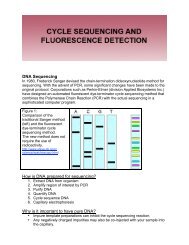DNA Cloning
DNA Cloning
DNA Cloning
Create successful ePaper yourself
Turn your PDF publications into a flip-book with our unique Google optimized e-Paper software.
Page 3<br />
Biol 312 L Molecular Biology Lab<br />
environment, pharmaceuticals, and novel alternative fuels. New applications or<br />
recombinant <strong>DNA</strong> are continually being discovered.<br />
Some steps are common to all recombinant <strong>DNA</strong> experiments that use plasmids:<br />
1. The <strong>DNA</strong> of interest (insert <strong>DNA</strong>) that is to be put in the plasmid must<br />
be isolated.<br />
2. A plasmid vector is obtained (usually commercially available).<br />
3. The insert <strong>DNA</strong> and plasmid <strong>DNA</strong> are cut with restriction enzymes<br />
that make compatible ends (see Figure 3.2).<br />
4. The insert <strong>DNA</strong> is joined by ligation into the plasmid (see Figure 3.2).<br />
5. The recombinant <strong>DNA</strong> construct is transferred into, and maintained in,<br />
a host cell (typically E. coli bacteria) by the process of transformation.<br />
The vector replicates with the bacteria, producing identical copies or<br />
clones of the insert <strong>DNA</strong>.<br />
6. The bacteria that have incorporated the foreign <strong>DNA</strong> are identified and<br />
isolated from untransformed cells.<br />
7. The cloned <strong>DNA</strong> can be manipulated so that the protein product it<br />
encodes can be expressed by the host cell.<br />
Topic I: RESTRICTION ENZYMES AND THEIR USE<br />
Restriction endonucleases (also called restriction enzymes) are some of the most<br />
powerful tools in molecular biology. Cutting <strong>DNA</strong> by using restriction enzymes is<br />
one of the most common molecular biology techniques and the availability of<br />
pure restriction enzymes was one of the first major advances in the new science<br />
of Molecular Biology. These enzymes occur naturally in bacteria and are used to<br />
protect the bacteria from invading foreign <strong>DNA</strong> such as bacterial viruses<br />
(bacteriophage).<br />
Restriction enzymes recognize specific sequences in <strong>DNA</strong> and then cleave<br />
the phosphodiester bonds between the nucleotides at that site. Any time<br />
this sequence appears in <strong>DNA</strong> it will be cleaved by the enzyme, whether it is viral<br />
or frog or human <strong>DNA</strong>. This is why restriction enzymes are so critical to<br />
molecular biology; they are very specific, cutting only at their unique recognition<br />
sequence, but they are also general because they will cut any <strong>DNA</strong> having this<br />
sequence. They work by cutting the <strong>DNA</strong> at a specific nucleotide sequence, the<br />
recognition sequence of the enzyme. The result is the generation of <strong>DNA</strong><br />
fragments (restriction fragments) from a <strong>DNA</strong> molecule having these<br />
recognition sequences or cut sites. Thus, digestion of a population of identical<br />
<strong>DNA</strong> molecules with a given enzyme will always result in identical restriction<br />
fragments. This is called an enzyme digestion and has made cloning and other<br />
<strong>DNA</strong> manipulations possible.<br />
Restriction enzymes (abbreviated RE) usually recognize palindromic sequences<br />
in <strong>DNA</strong> (See Figure 3.1). For example, the widely used restriction enzyme



